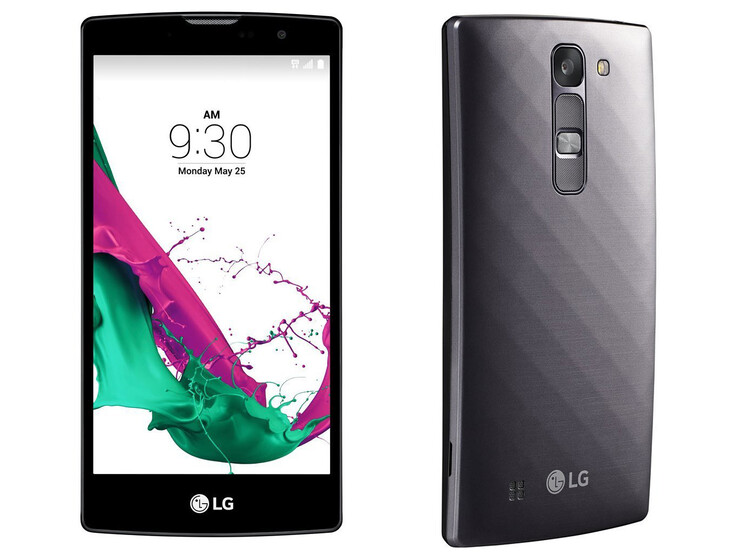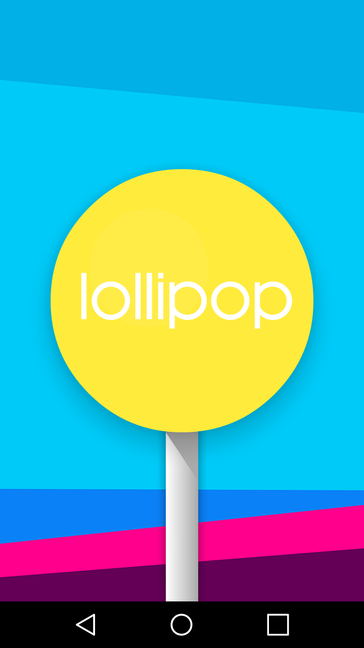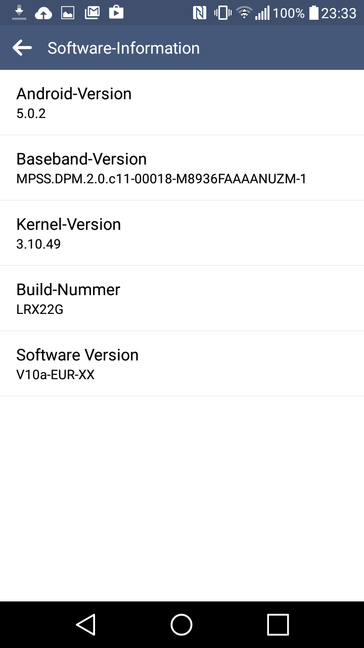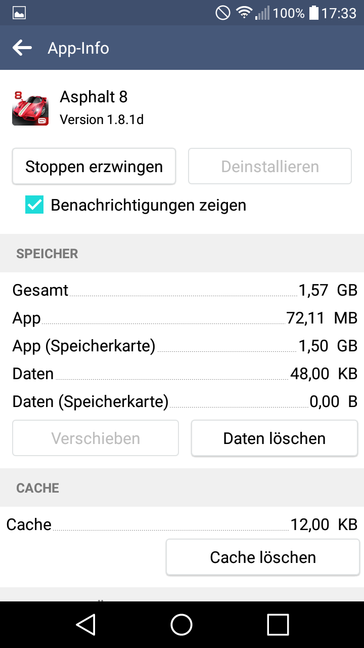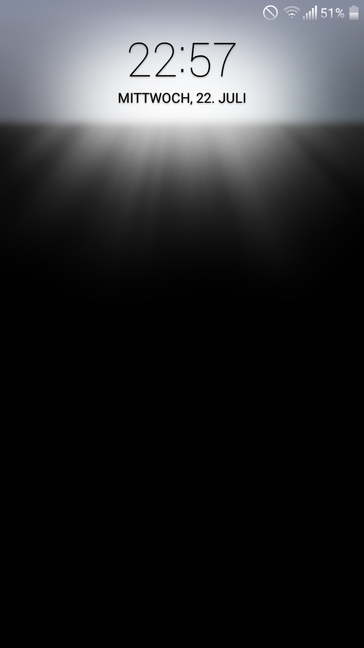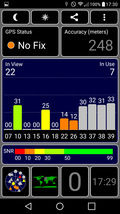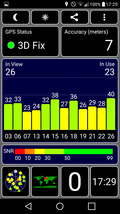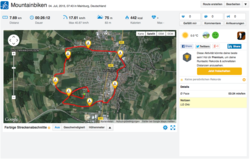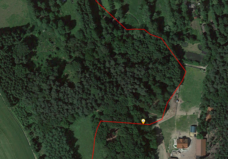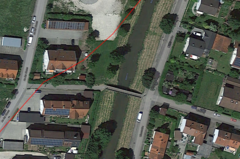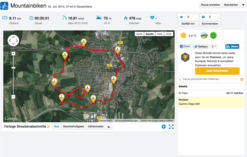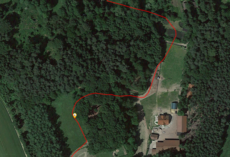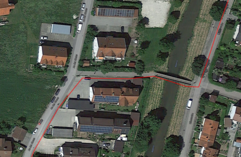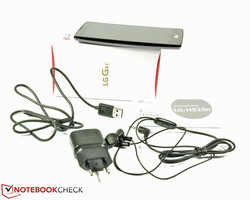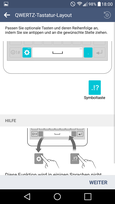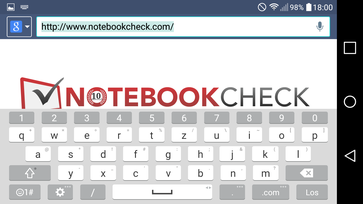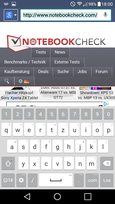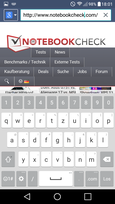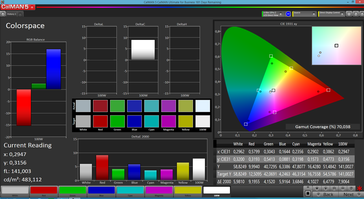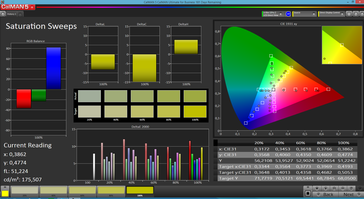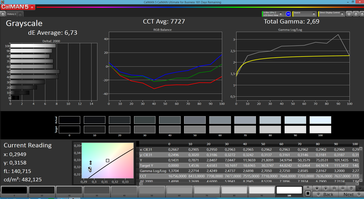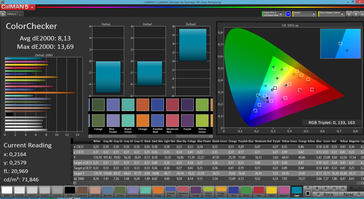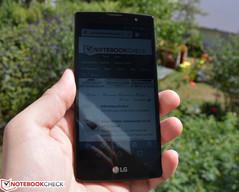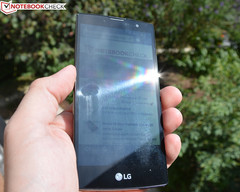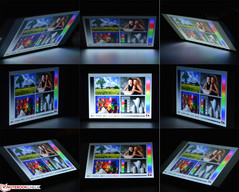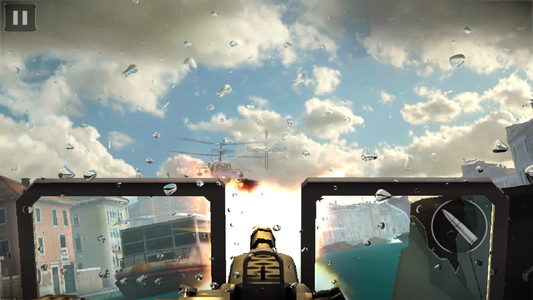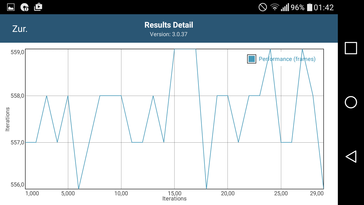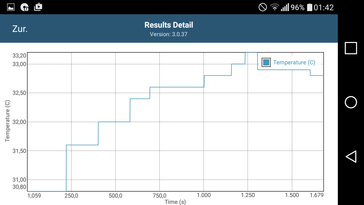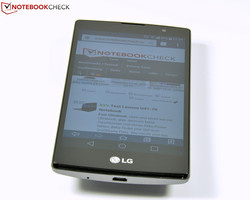LG G4c Smartphone Review
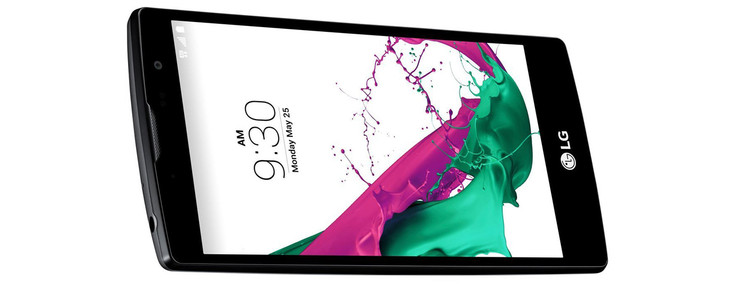
For the original German review, see here.
The South Korean entertainment giant LG expands its G4 lineup with an affordable sister model dubbed LG G4c. The 5-inch phone obviously follows the design of the slightly curved LG G4 top model. However, it makes deductions in configuration and price. The storage can still be extended and the battery replaced. In return, more basic camera modules with 8 MP on the rear and 5 MP on the front are installed. Both LTE and NFC are also still on-board. LG-specific features, such as the "Knock Code," are also present. Android 5.0.2 Lollipop alongside LG's usual UI is the operating system. In addition to the metallic-gray review sample, LG's G4c is also available in white, gold and silver for an RRP of 279 Euros (~$306).
LG's G4c will compete with Huawei's P8 lite, Sony's Xperia M4 Aqua and Samsung's Galaxy S5 Mini besides its bigger brother LG G4 in the direct comparison.
Case
The design of LG's G4c is loosely based on that of its bigger brother, but it uses a not quite as elegant plastic back that, however, features an attractive diamond pattern and brushed aluminum looks. Unfortunately, the plastic is relatively susceptible to scratches, which can be seen well on our not much used review sample.
The G4c is not a thin smartphone with a thickness of 10.2 mm, which is also due to its curved design in contrast to its rivals. Its size is relatively compact, and the lightly curved casing makes it pleasant to hold. The lateral frame is very thin, and the narrow rims at the upper and lower edges ensure a secure hold without danger of accidentally brushing the touchscreen. Like the bigger LG G4 brother, LG's G4c successfully passed our pressure and warping tests. The overall build is impeccable and well done. The entire back cover can be removed and conceals the slots for a micro-SIM and micro-SD card. The manufacturer specifies a maximum of 32 GB, but the device identified our 64 GB card from SanDisk without problems in the test. The battery can also be removed.
Connectivity
The micro-USB slot operates in the 2.0 standard but does not support USB OTG. Wireless transmission of media from and to a compatible device is also possible via Android Beam and NFC. Android 4.0 and NFC are the minimum requirements for this, making it fast and easy to share photos, videos, contacts, websites, and more. The latest Bluetooth 4.1 standard is also installed.
The internal storage of factual usable 3.27 GB is very tight. However, it can be extended by up to 32 GB via micro-SD; our review sample even accepted a 64 GB memory card. App2SD is possible with restrictions. For example, we could move the game Asphalt 8: Airborne but not the app Drop Box in our test.
Software
LG's G4c uses Google's Android 5.0.2 Lollipop, which is covered by LG's proprietary UI LG UX 4.0. That also brings the trendy "flat look" of app icons on the screen. It is great that LG does not preload much bloatware that cannot be uninstalled. Useful extras like "LG Backup" or the well-known Google bundle are also installed, even if not as comprehensively as in the flagship LG G4. For example, the "Smart Bulletin Board" or "Smart Settings" have been omitted. A clever and at the same time battery-sparing idea is "Glance View." Swiping down over the screen displays the upper status bar with information about signal strength, battery status, time and date.
Communication & GPS
LG's G4c offers mobile data connections via HSPA+ (upload max. 5.76 Mbps; download max. 42 Mbps) and LTE Cat. 4 (upload/download: 50 MBps/150 MBps). Furthermore, NFC and Bluetooth 4.1 transmit over close ranges. Quad-band GSM, dual-band UMTS and tri-band LTE provide sufficient frequency coverage, at least in Europe. As appropriate for this price range, the Wi-Fi module supports the IEEE 802.11 b/g/n standards and transmits in both the 2.4 and 5.0 GHz frequency ranges available in Germany. The range is good. It was still average at a distance of about 10 meters from the router and through several walls. No interruptions were noticed in the test. Internet browsing was sufficiently fast, and streaming HD videos from the Web was lag-free.
The review sample uses A-GPS and GLONASS networks for localization. Indoor tracking was not possible, but satellites could find us quite accurately after half a minute. LG's G4c gave a mixed performance in the comparison with the Garmin Edge 500 bike navigation system. It presented a deviation of 0.42 km over the total route. The review sample tended to take shortcuts in particular paths through the woods and very serpentine routes. The overall performance was still good, though.
Telephone & Call Quality
The phone app offers the usual Android standard with all important features. The call quality is only middling and annoys with occasional crackling and a consistently high base noise. There were no voice dropouts during the test call. The speaker is only useful in quiet surroundings. It started to overdrive increasingly at about half the maximum volume, and speech became unintelligible.
Cameras & Multimedia
The cameras have been slimmed down evidently compared with those in LG's G4. However, the front-facing camera still has a decent 5 MP alongside a wide angle lens for selfies and groufies. LG offers multiple features, such as "Touch & Shoot," voice or gesture control, for simple selfies. "Live View" is minimized in dim surroundings, and the rest of the screen serves as flash replacement, which functioned well in a close range. Although the color reproduction is generally satisfactory, the photos lack some sharpness and contrast. The low-light performance is still acceptable.
The rear-facing primary camera has a resolution of 8 MP and does not feature an image stabilizer or ambient light sensor. The photos thus suffer under high image noise and poor focus when the object is not illuminated sufficiently, which is due to the missing laser auto-focus. The other features are also only standard. At least voice control via predetermined code words functioned well. Photos are only middling even in good ambient light; they simply lack sharpness. The sensor also often overexposes, which results in too bright images and slightly inaccurate color reproduction.
Accessories
In addition to the phone, LG packs a standard headset in the box. Besides that, a charging adapter, an approximately 90 cm USB cable and a quick-start guide are found. LG does not yet offer any product-specific accessories, but we would guess that a tailored cover with window will soon be offered for LG's G4c since the option "QuickCircle Case" is available in the settings.
Warranty
LG includes a 24-month warranty on the phone; the battery and accessories are covered for 6 months.
Input Devices & Handling
Thanks to its decent sleekness and high sensitivity up into the corners, using the capacitive touchscreen is good. Inputs were implemented quite fast; screen rotation needed a second, though. The keyboard is easy to adapt according to personal preferences and functions quickly and reliably. The gimmick of pulling the keyboard apart in landscape mode or using the cursor in the word suggestion bar via elongated pressure on the space bar known from LG's G4 also functioned superbly with the G4c.
LG's G4c again relies on the familiar rear-key design: Power button and volume keys are directly under the camera module on the rear. It functions very well after getting used to this control method.
Display
The 5-inch screen of LG's G4c in the 16:9 format has a category typical HD resolution of 1280x720 pixels and a pixel density of 294 ppi. Gorilla Glass 3 protects the underlying TFT IPS LCD screen. The screen is lightly curved, which is more for show and USP than a true added value that the more curved LG G4 offers. The maximum brightness of 480 cd/m² is a good rate and easily outshines Huawei's P8 lite and Samsung's Galaxy S5 Mini. However, it cannot compete with LG's G4 or Sony's Xperia M4 Aqua with over 550 cd/m². The very homogeneous illumination of 92% is on the high level of the comparison group.
| |||||||||||||||||||||||||
Brightness Distribution: 92 %
Center on Battery: 480 cd/m²
Contrast: 980:1 (Black: 0.49 cd/m²)
ΔE ColorChecker Calman: 8.13 | ∀{0.5-29.43 Ø4.78}
ΔE Greyscale Calman: 6.73 | ∀{0.09-98 Ø5}
70.038% sRGB (Argyll 1.6.3 3D)
Gamma: 2.69
CCT: 7727 K
| LG G4c Adreno 306, 410 MSM8916, 8 GB eMMC Flash | LG G4 Adreno 418, 808 MSM8992, 32 GB eMMC Flash | Huawei P8 lite Mali-450 MP4, Kirin 620, 16 GB eMMC Flash | Samsung Galaxy S5 mini Mali-400 MP4, 3470 Quad, 16 GB eMMC Flash | Sony Xperia M4 Aqua Adreno 405, 615 MSM8939, 8 GB eMMC Flash | |
|---|---|---|---|---|---|
| Screen | 16% | 4% | -8% | 2% | |
| Brightness middle (cd/m²) | 480 | 566 18% | 365 -24% | 288 -40% | 547 14% |
| Brightness (cd/m²) | 464 | 536 16% | 353 -24% | 289 -38% | 535 15% |
| Brightness Distribution (%) | 92 | 90 -2% | 93 1% | 88 -4% | 92 0% |
| Black Level * (cd/m²) | 0.49 | 0.47 4% | 0.42 14% | 0.81 -65% | |
| Contrast (:1) | 980 | 1204 23% | 869 -11% | 675 -31% | |
| Colorchecker dE 2000 * | 8.13 | 6.17 24% | 5.2 36% | 6.18 24% | 5.77 29% |
| Greyscale dE 2000 * | 6.73 | 6.26 7% | 5.85 13% | 5.52 18% | 5.87 13% |
| Gamma | 2.69 82% | 2.48 89% | 2.17 101% | 2.23 99% | 2.14 103% |
| CCT | 7727 84% | 8171 80% | 7252 90% | 7256 90% | 7784 84% |
| Color Space (Percent of sRGB) (%) | 70.038 | 98.63 41% | 91.25 30% | 96.5753 38% | |
| Color Space (Percent of AdobeRGB 1998) (%) | 65.48 | 70.86 | 72.0875 |
* ... smaller is better
LG's G4c can also hold its own with a good black level of 0.49 cd/m² and a very high contrast of 980:1. Only the AMOLED screen in Samsung's Galaxy S5 Mini defeats it for technological reasons.
LG's G4c does not do quite as a good job in color reproduction. The color brightness is slightly lower than the ideal, and a light red-green deficit as well as a bluish tint is evident. The latter is already visible in the darker tones in grayscale level, which a too high DeltaE of 6.73 also confirms. The gamma rate of 2.69 is close to the ideal rate, but the color temperature is somewhat too high (norm value: 6500 K). The shifts in the mixed colors are also a bit high; we measured a DeltaE of 8.13 here. Although these shortcomings were not noticed adversely in real-world use, enthusiastic photographers should first judge their snapshots on a computer.
Although the high brightness of LG's G4c makes it suitable for outdoor use, the strong reflections on the screen's surface in direct light are distracting. Nevertheless, the smartphone is generally good to use outdoors.
Thanks to the IPS panel, the screen has very stable viewing angles. No color distortions are seen even in extreme viewing angles. A minor grayish tint covers the content only in bright image areas.
Performance
LG's G4c is powered by Qualcomm's Snapdragon 410 quad-core SoC that clocks at 1.2 GHz. Qualcomm's integrated Adreno 306 graphics card and 1 GB of RAM support it.
The smartphone makes a mixed impression in the benchmarks. It can just surpass Samsung's Galaxy S5 Mini in some benchmarks like Geekbench 3 or Linpack and even outperform all contenders, except the much stronger LG G4, in Smartbench 2012. However, it is very clearly defeated in AnTuTu v5 or the newer GFX benchmarks.
Although the smartphone runs quite smoothly in conjunction with Android 5.0.2, it often needs a moment for starting apps or in the app drawer. The available performance is enough for routine use if the user does not have too high demands, though.
| Geekbench 3 | |
| 32 Bit Single-Core Score (sort by value) | |
| LG G4c | |
| LG G4 | |
| Samsung Galaxy S5 mini | |
| Sony Xperia M4 Aqua | |
| 32 Bit Multi-Core Score (sort by value) | |
| LG G4c | |
| LG G4 | |
| Samsung Galaxy S5 mini | |
| Sony Xperia M4 Aqua | |
| Smartbench 2012 - Productivity Index (sort by value) | |
| LG G4c | |
| LG G4 | |
| Samsung Galaxy S5 mini | |
| Huawei P8 lite | |
| Sony Xperia M4 Aqua | |
| Linpack Android / IOS | |
| Single Thread (sort by value) | |
| LG G4c | |
| LG G4 | |
| Samsung Galaxy S5 mini | |
| Sony Xperia M4 Aqua | |
| Multi Thread (sort by value) | |
| LG G4c | |
| LG G4 | |
| Samsung Galaxy S5 mini | |
| Sony Xperia M4 Aqua | |
| AnTuTu v5 - Total Score (sort by value) | |
| LG G4c | |
| LG G4 | |
| Huawei P8 lite | |
| Sony Xperia M4 Aqua | |
| GFXBench (DX / GLBenchmark) 2.7 | |
| T-Rex Onscreen (sort by value) | |
| LG G4c | |
| LG G4 | |
| Samsung Galaxy S5 mini | |
| Huawei P8 lite | |
| Sony Xperia M4 Aqua | |
| 1920x1080 T-Rex Offscreen (sort by value) | |
| LG G4c | |
| LG G4 | |
| Samsung Galaxy S5 mini | |
| Huawei P8 lite | |
| Sony Xperia M4 Aqua | |
| GFXBench 3.0 | |
| 1920x1080 1080p Manhattan Offscreen (sort by value) | |
| LG G4c | |
| LG G4 | |
| Sony Xperia M4 Aqua | |
| on screen Manhattan Onscreen OGL (sort by value) | |
| LG G4c | |
| LG G4 | |
| Sony Xperia M4 Aqua | |
| PCMark for Android - Work performance score (sort by value) | |
| LG G4c | |
| LG G4 | |
| Huawei P8 lite | |
| Sony Xperia M4 Aqua | |
The browser-based benchmarks tests also vary strongly. For example, LG's G4c can outrun Huawei's P8 lite and Samsung's Galaxy S5 Mini in Google's Octane v2 benchmark and Google's V8v7 test, but it comes in last in the SunSpider 1.0 benchmark. That is occasionally noticed in the somewhat longer load times when browsing, but that does not ruin the browsing fun with LG's G4c.
| Sunspider - 1.0 Total Score (sort by value) | |
| LG G4c | |
| LG G4 | |
| Samsung Galaxy S5 mini | |
| Huawei P8 lite | |
| Sony Xperia M4 Aqua | |
| Google V8 Ver. 7 - Google V8 Ver. 7 Score (sort by value) | |
| LG G4c | |
| LG G4 | |
| Huawei P8 lite | |
| Sony Xperia M4 Aqua | |
| Octane V2 - Total Score (sort by value) | |
| LG G4c | |
| LG G4 | |
| Samsung Galaxy S5 mini | |
| Huawei P8 lite | |
| Sony Xperia M4 Aqua | |
| Mozilla Kraken 1.1 - Total (sort by value) | |
| LG G4c | |
| LG G4 | |
| Samsung Galaxy S5 mini | |
| Huawei P8 lite | |
| Sony Xperia M4 Aqua | |
| WebXPRT 2015 - Overall (sort by value) | |
| LG G4c | |
| LG G4 | |
| Huawei P8 lite | |
| Sony Xperia M4 Aqua | |
* ... smaller is better
The Androbench Benchmark test checks the storage speed and that of the controller for the inserted micro-SD memory card of LG's G4c. The review sample marks the last place in most tests here; only Samsung's Galaxy S5 Mini is usually even a bit slower. However, we did not ascertain any excessively long waiting times in the real-world test.
| AndroBench 3-5 | |
| Random Write 4KB (sort by value) | |
| LG G4c | |
| LG G4 | |
| Samsung Galaxy S5 mini | |
| Huawei P8 lite | |
| Sony Xperia M4 Aqua | |
| Random Read 4KB (sort by value) | |
| LG G4c | |
| LG G4 | |
| Samsung Galaxy S5 mini | |
| Huawei P8 lite | |
| Sony Xperia M4 Aqua | |
| Sequential Write 256KB (sort by value) | |
| LG G4c | |
| LG G4 | |
| Samsung Galaxy S5 mini | |
| Huawei P8 lite | |
| Sony Xperia M4 Aqua | |
| Sequential Read 256KB (sort by value) | |
| LG G4c | |
| LG G4 | |
| Samsung Galaxy S5 mini | |
| Huawei P8 lite | |
| Sony Xperia M4 Aqua | |
Games
The integrated Qualcomm Adreno 306 graphics card is a member of the mid-range and can render most up-to-date games smoothly even if the details have to sometimes be reduced. Both Modern Combat 5 and Angry Birds Fight! ran without issues in the test. The decent touchscreen and the sensors function swiftly and accurately, and the precise game control contributes to gaming enjoyment.
Emissions
Temperature
The idle temperatures of LG's G4c always remain in an uncritical range with an average of 28.9 °C on the upper side and 28.7 °C on the underside. The device also only heats up marginally under load with 34.7 °C on the front and 33.5 °C on the rear, which is just lukewarm. Only Samsung's Galaxy S5 Mini is on par with that in the comparison field. We performed our stress test on LG's G4c using the battery test of GFXBench 3.0 to evaluate the temperature development in routine use. The T-Rex benchmark runs 30 times in succession, and the performance and temperature are recorded in addition to the battery's status. Here, the frame rates fluctuate invariably, the temperature increases gradually but not linearly. However, we did not observe temperature-related performance throttling in the real-world test with 3D games.
(+) The maximum temperature on the upper side is 37.1 °C / 99 F, compared to the average of 35.2 °C / 95 F, ranging from 21.9 to 247 °C for the class Smartphone.
(+) The bottom heats up to a maximum of 36 °C / 97 F, compared to the average of 34 °C / 93 F
(+) In idle usage, the average temperature for the upper side is 28.9 °C / 84 F, compared to the device average of 32.9 °C / 91 F.
Speaker
Like previously in LG's G4, the mono speaker in LG's G4c position on the lower rear is not ideal and will often be covered by a hand. The cost-cutting measures are audible in sound quality; LG's G4 has a considerably richer sound. Although trebles are rendered satisfactorily, bass and mids are pushed extremely into the background. We cannot agree with LG's salient assertion that the 1-watt speaker renders both low and high tones perfectly clear and makes additional speakers superfluous. The sound output via the 3.5 mm jack does not give reason for complaint.
Battery Runtime
The battery in LG's G4c has 9.6 Wh (2540 mAh) and is removable. However, that is not necessary because the runtimes are very good and outperform all rivals in almost all tests. Only Samsung's Galaxy S5 Mini lasts a bit longer in the Full HD video loop using Big Buck Bunny with a screen brightness set to 55% (150 cd/m²). 4:12 hours was possible under full load via the app Stability Test. The contenders needed a refill much sooner. We ascertained a maximum of almost 16 hours in the Reader's test with minimum screen brightness. Only LG's G4 (11.55 Wh/3000 mAh) and Samsung's Galaxy S5 Mini (8.1 Wh/2100 mAh) last longer here. The runtimes are best compared in the Wi-Fi browsing test that we also perform using an adapted brightness (150 cd/m²). Over 7.5 hours is impressive, and only Sony's Xperia M4 Aqua (7 hours) comes even close to that. LG G4c owners will thus not have to buy an additional battery right away because the G4c will easily manage a workday remote from an outlet with adapted brightness.
| LG G4c Adreno 306, 410 MSM8916, 8 GB eMMC Flash | LG G4 Adreno 418, 808 MSM8992, 32 GB eMMC Flash | Samsung Galaxy S5 mini Mali-400 MP4, 3470 Quad, 16 GB eMMC Flash | Huawei P8 lite Mali-450 MP4, Kirin 620, 16 GB eMMC Flash | Sony Xperia M4 Aqua Adreno 405, 615 MSM8939, 8 GB eMMC Flash | |
|---|---|---|---|---|---|
| Battery runtime | -38% | -9% | -31% | -16% | |
| H.264 (h) | 11.8 | 8.4 -29% | 12.6 7% | 6.2 -47% | 8.6 -27% |
| WiFi v1.3 (h) | 7.6 | 5.4 -29% | 5.9 -22% | 7 -8% | |
| Load (h) | 4.2 | 1.9 -55% | 3.2 -24% | 3.2 -24% | 3.7 -12% |
| WiFi (h) | 14.2 |
Pros
Cons
Verdict
Buyers of LG's G4c will find a decent smartphone with a bright IPS screen and very good battery life at a price of approximately 250 Euros (~$274). However, flagship features should not be expected. LTE Cat. 4 and 802.11 b/g/n dual-band Wi-Fi alongside NFC are on-board though. The sufficiently strong SoC and good build are also compelling for this price range. Anyone anticipating the superb cameras of LG's G4 will be slightly disappointed even if the lenses shoot fairly decent pictures - as long as the lighting is good. We would, however, appreciate better call quality and a bigger internal storage, although it can be expanded by up to 64 GB via micro-SD. Furthermore, the smooth operation and low temperature development are also positive. We did not like the inaccurate GPS and middling speaker as much, though.
Users who value a good price-performance ratio without having to make too many compromises in everyday use should risk a glance at LG's G4c.
Everyone else looking for a smartphone without real shortcomings should look closer at the Samsung Galaxy S5 Mini. The Huawei P8 lite is also an interesting alternative.
LG G4c
- 07/24/2015 v4 (old)
Michael Moser





